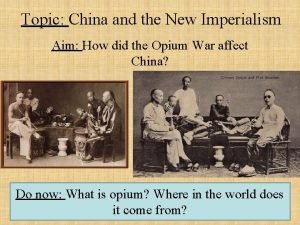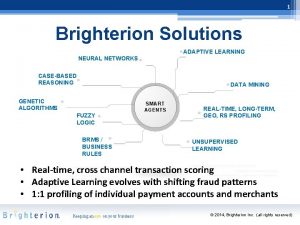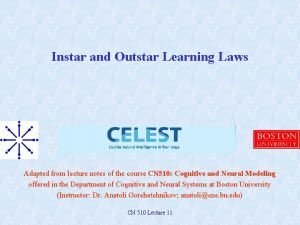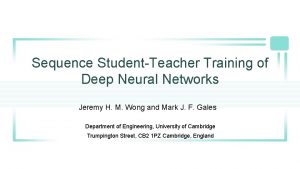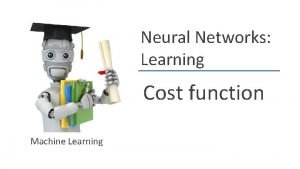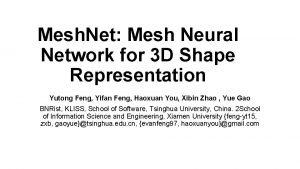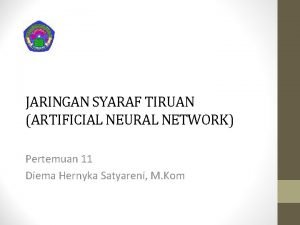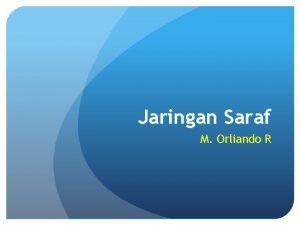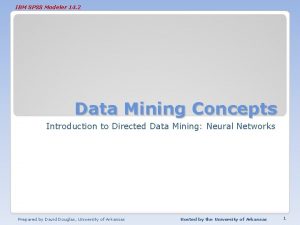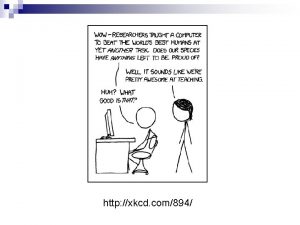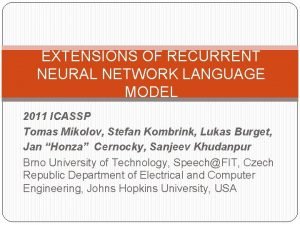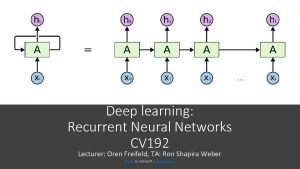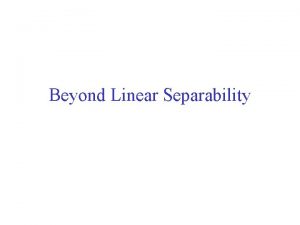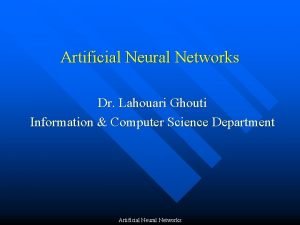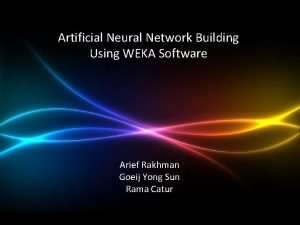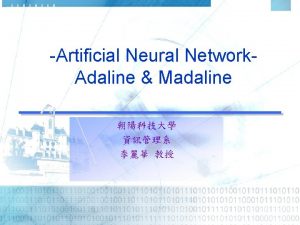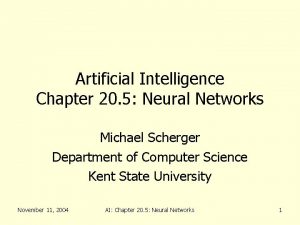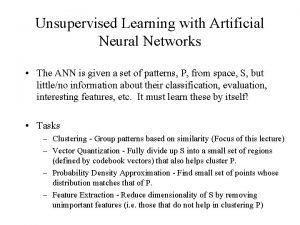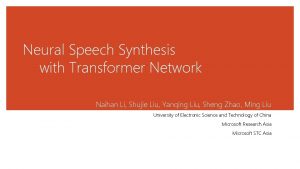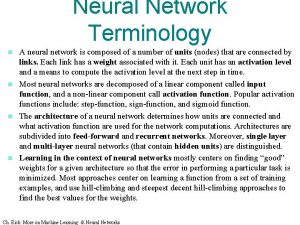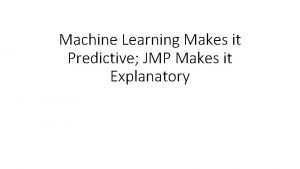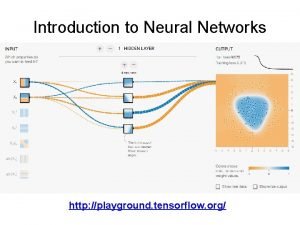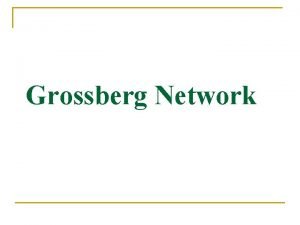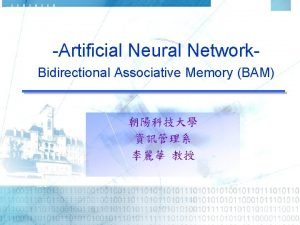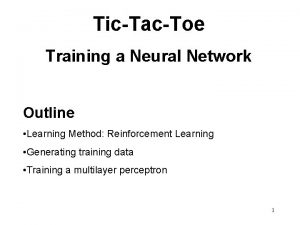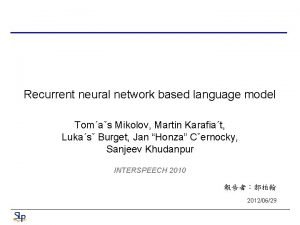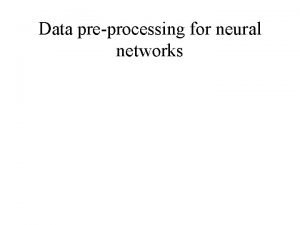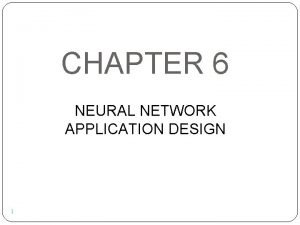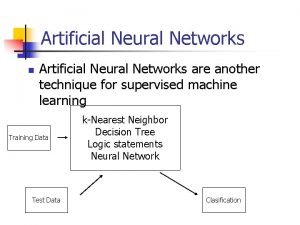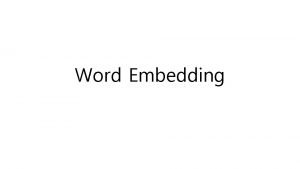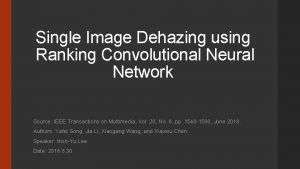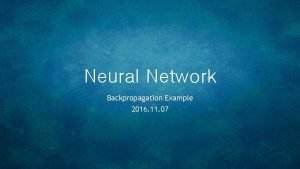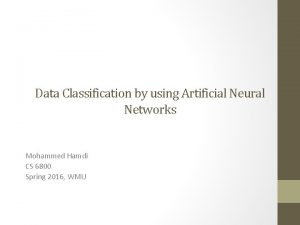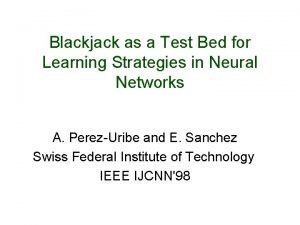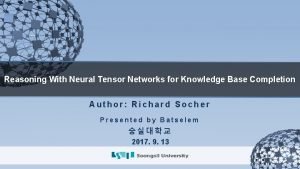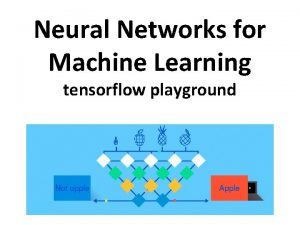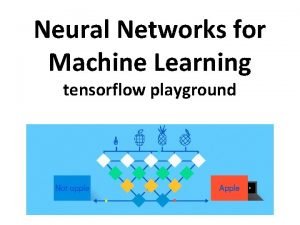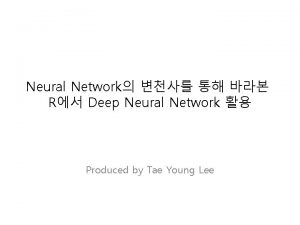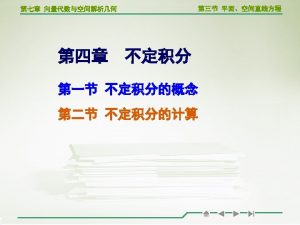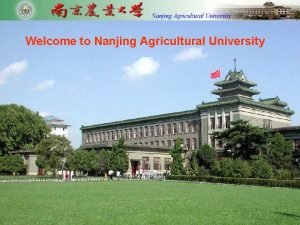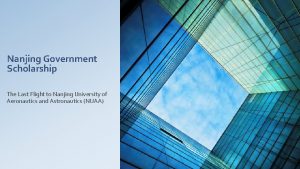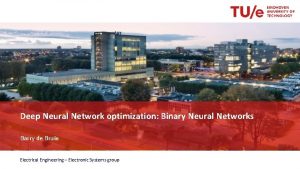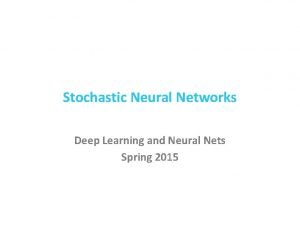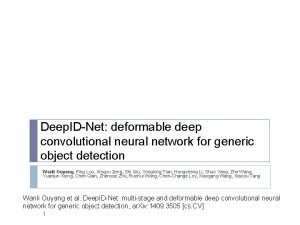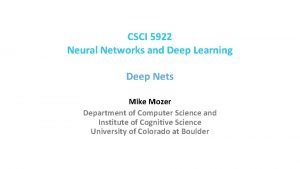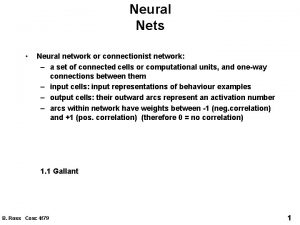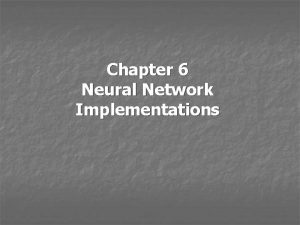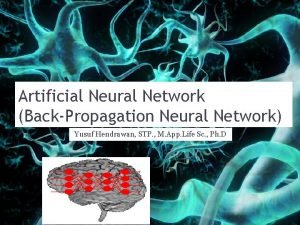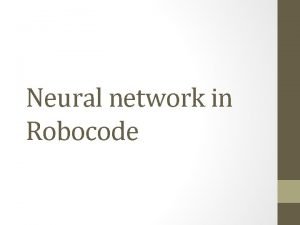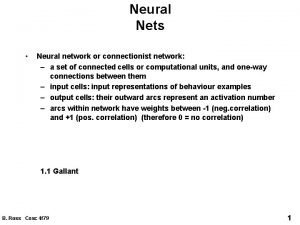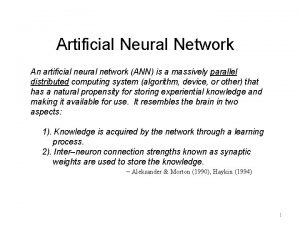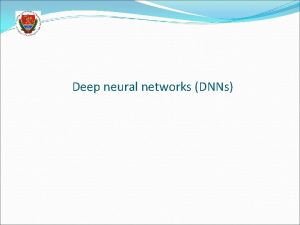Neural network and deep learning Chunyan Xu Nanjing






















































- Slides: 54

Neural network and deep learning Chunyan Xu Nanjing University of Science and Technology 2019 -06 -17

Outline Neural network Deep learning (Before 2006) (2006 -now) Applications Ø Biological Neurons Ø 1989 Ø Virtual reality Ø Perceptron Yann Lecun Ø Deep driving Ø Basic knowledge Ø 2006 (Person detection) l Feed-forward Hinton Ø Video object l Training Ø 2012 Segmentation l Error BP Alex Krizhevsky Ø Pose estimation

Biological Neurons

Artificial Neural Networks (ANN)

Layered Networks Input nodes Connections Output nodes Hidden nodes

The simplest model- Perceptron • The Perceptron was introduced in 1957 by Frank Rosenblatt. Perceptron: - D 0 d D 1 Activation functions: D 2 Update Learning: Input Layer Output Destinations Layer

Second generation neural networks (~1985) Back-propagate Compare outputs with correct answer to get error signal to error signal get derivatives for learning outputs hidden layers input vector

Some basic knowledge Ø Feed-forward Networks Ø Network Training Ø Error Back-propagation

Feed-forward networks

Feed-forward networks

Feed-forward networks

Activation functions

Feed-forward networks

Feed-forward networks

Network training

Parameter Optimization

Descent Methods

Computing gradients

Error back-propagation

Chain rule for partial derivatives

Error back-propagation

Error back-propagation

Error back-propagation



CNN Yann Le. Cun 1989 Y. Le. Cun, L. Bottou, Y. Bengio, and P. Haffner, Gradient-based learning applied to document recognition, Proceedings of the IEEE 86(11): 2278– 2324, 1998.

CNN Yann Le. Cun DBN Science Hinton 1989 2006 o Large-scale data o Better algortithms Unsupervised and lay-wise learning o Much powerful GPU Hinton, G. E. and Salakhutdinov, R. R. (2006) Reducing the dimensionality of data with neural networks. Science, Vol. 313. no. 5786, pp. 504 - 507, 28 July 2006

DBN Science Hinton CNN Yann Le. Cun Imagenet Alex 1989 2006 2012 Order groups errors algorithms 1 Toronto 15. 32% Deep CNN 2 Tokyo 26. 17% 3 Oxford 26. 98% 4 INRIA 27. 06% hand designed feature for image classification • The results of Image. Net 2012 competition • Dataset: 1, 000 images with 1000 classes A. Krizhevsky, I. Sutskever, and G. E. Hinton. Imagenet classification with deep convolutional neural networks. In Advances in neural information processing systems, pages 1097– 1105. 2012.

CNN Yann Le. Cun DBN Science Hinton Imagenet Alex 1989 2006 2012 Ø Alex Krizhevsky, Ilya Sutskever, Geoffrey E. Hinton, Image. Net Classification with Deep Convolutional Neural Networks. NIPS 2012: 1106 -1114

CNN Yann Le. Cun DBN Science Hinton Image. Net LFW Alex Face recognition 1989 2006 2012 2014 The deep learning algorithms has achieved 99. 15% accuracy on LFW face verification dataset, which is almost near to human recognition. Y. Sun, X. Wang, and X. Tang. Deep Learning Face Representation by Joint Identification-Verification. NIPS, 2014.

Deep Learning Ø Deep learning (a. k. a. representation learning) seeks to learn rich hierarchical representations (i. e. features) automatically through multiple stage of feature learning process. Low-level features Mid-level features High-level features Trainable classifier output Feature visualization of convolutional net trained on Image. Net (Zeiler and Fergus, 2013)

Learning Hierarchical Representations Lowlevel features Midlevel features High-level features Trainable classifier output Increasing level of abstraction Ø Hierarchy of representations with increasing level of abstraction. Each stage is a kind of trainable nonlinear feature transform Ø Image recognition – Pixel → edge → texton → motif → part → object Ø Text – Character → word group → clause → sentence → story

Convolutional Neural Network Ø Input can have very high dimension. Using a fully-connected neural network would need a large amount of parameters. Ø Inspired by the neurophysiological experiments conducted by [Hubel & Wiesel 1962], CNNs are a special type of neural network whose hidden units are only connected to local receptive field. The number of parameters needed by CNNs is much smaller. Example: 200 x 200 image a) fully connected: 40, 000 hidden units => 1. 6 billion parameters b) CNN: 5 x 5 kernel, 100 feature maps => 2, 500 parameters

Three Stages of a Convolutional Layer Ø

Convolution Operation in CNN Ø Ø Input: an image (2 -D array) x Convolution kernel/operator(2 -D array of learnable parameters): w Feature map (2 -D array of processed data): s Convolution operation in 2 -D domains:

Multiple Convolutions Usually there are multiple feature maps, one for each convolution operator.

Non-linearity Tanh(x) Re. LU

Pooling Ø Common pooling operations: – Max pooling: reports the maximum output within a rectangular neighborhood. – Average pooling: reports the average output of a rectangular neighborhood (possibly weighted by the distance from the central pixel).

Deep CNN: winner of Image. Net 2012 (Alex et al. , 2012) Ø Multiple feature maps per convolutional layer. Ø Multiple convolutional layers for extracting features at different levels. Ø Higher-level layers take the feature maps in lower-level layers as input.

CNN for Image Classification Try out a live demo at http: //demo. caffe. berkeleyvision. org/

Classical CNN models Alex. Net NIN VGG Goo. Lenet Dense. Net Mobile. Net Dual Path Net Shuffle. Net

Deep driving Ø C. Chen, A. Seff, A. Kornhauser and J. Xiao, Deep. Driving: Learning Affordance for Direct Perception in Autonomous Driving, ICCV 2015.

Object detection Ø R-CNN Ø R. Girshick, J. Donahue, T. Darrell, J. Malik, Rich Feature Hierarchies for Accurate Object Detection and Semantic Segmentation, CVPR 2014, oral.

Object detection Ø Fast R-CNN – – Ross Girshick, ICCV 2015, ORAL.

Object detection Ø Faster R-CNN Ø Shaoqing Ren, Kaiming He, Ross Girshick, Jian Sun, Faster R-CNN: Towards Real-Time Object Detection with Region Proposal Networks, NIPS 2015.

Object detection demo

Image segmentation Ø Jon Long*, Evan Shelhamer*, Trevor Darrell, Fully Convolutional Networks for Semantic Segmentation, CVPR 2015 best paper.

Image segmentation Ø Seunghoon Hong, Hyeonwoo Noh, Bohyung Han, Decoupled Deep Neural Network for Semi-supervised Semantic Segmentation, NIPS 2015.

Image segmentation Ø Ø Hyeonwoo Noh, Seunghoon Hong, Bohyung Han, Learning Deconvolution Network for Semantic Segmentation, ICCV 2015. Seunghoon Hong, Hyeonwoo Noh, Bohyung Han, Decoupled Deep Neural Network for Semi-supervised Semantic Segmentation, NIPS 2015.

Segmentation demo

Art + CNN Ø L. A. Gatys, A. S. Ecker, and M. Bethge, A Neural Algorithm of Artistic Style, ar. Xiv, 2015

Art + CNN Ø L. A. Gatys, A. S. Ecker, and M. Bethge, A Neural Algorithm of Artistic Style, ar. Xiv, 2015

Art + CNN

Email: cyx@njust. edu. cn
 Deep forest towards an alternative to deep neural networks
Deep forest towards an alternative to deep neural networks Renaissance nanjing olympic centre hotel
Renaissance nanjing olympic centre hotel Treaty of nanjing in 1842
Treaty of nanjing in 1842 Adaptive learning neural network
Adaptive learning neural network Deep learning approach and surface learning approach
Deep learning approach and surface learning approach Mippers
Mippers Cmu machine learning
Cmu machine learning Efficient processing of deep neural networks
Efficient processing of deep neural networks Deep asleep deep asleep it lies
Deep asleep deep asleep it lies 深哉深哉
深哉深哉 Instar and outstar in neural network
Instar and outstar in neural network Neural networks and learning machines 3rd edition
Neural networks and learning machines 3rd edition Neural networks and learning machines
Neural networks and learning machines Formation of neural networks ib psychology
Formation of neural networks ib psychology Student teacher neural network
Student teacher neural network Cost function in neural network
Cost function in neural network Threshold logic unit in neural network
Threshold logic unit in neural network Meshnet: mesh neural network for 3d shape representation
Meshnet: mesh neural network for 3d shape representation Pengertian artificial neural network
Pengertian artificial neural network Neural network in r
Neural network in r Introduction to neural networks using matlab
Introduction to neural networks using matlab Spss neural network
Spss neural network Xkcd neural network
Xkcd neural network Extensions of recurrent neural network language model
Extensions of recurrent neural network language model Draw: a recurrent neural network for image generation
Draw: a recurrent neural network for image generation What is stride in cnn
What is stride in cnn Limitations of perceptron:
Limitations of perceptron: Artificial neural network in data mining
Artificial neural network in data mining Least mean square algorithm in neural network
Least mean square algorithm in neural network Ann weka
Ann weka Adaline madaline
Adaline madaline Decision boundary of neural network
Decision boundary of neural network Maxnet neural network
Maxnet neural network Reported speech transformer
Reported speech transformer Artificial neural network terminology
Artificial neural network terminology Jmp pca
Jmp pca Playground.tensorflow.org
Playground.tensorflow.org Neuronoff
Neuronoff Neural network in data mining
Neural network in data mining Auto associative memory
Auto associative memory Convolutional neural network alternatives
Convolutional neural network alternatives Vc dimension of neural networks
Vc dimension of neural networks Neural network tic tac toe
Neural network tic tac toe Recurrent neural network based language model
Recurrent neural network based language model Neural network data preprocessing
Neural network data preprocessing Network application design
Network application design Multilayer neural network
Multilayer neural network Nnlm neural network
Nnlm neural network Convolutional neural network
Convolutional neural network Backpropagation example
Backpropagation example Maxnet neural network
Maxnet neural network Blackjack neural network
Blackjack neural network Matt damon
Matt damon Tensor flow playground
Tensor flow playground Tensorflow playgorund
Tensorflow playgorund


